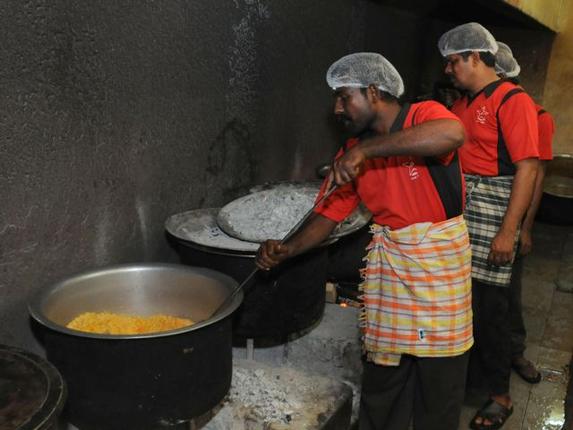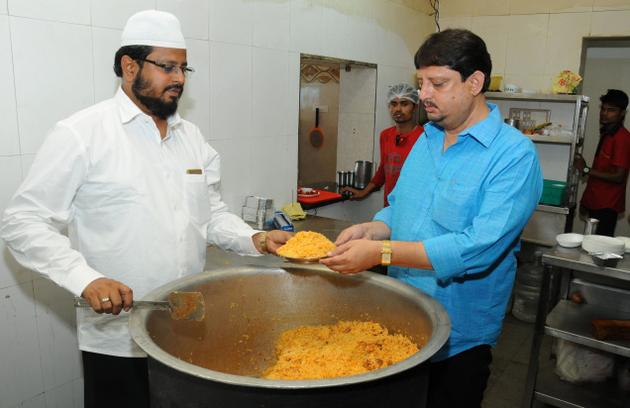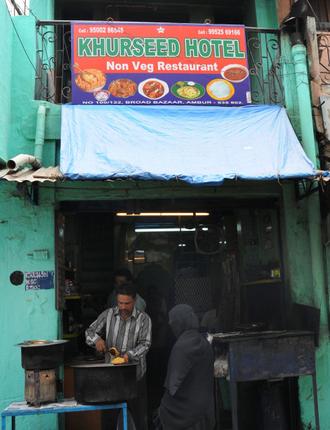
The writer spends a day tasting the town’s staple dish to find out what makes it so appealing.
There was once a man who loved biryani so much that he braved the rain to eat it under the leaky roof of an eatery. Another ate it for lunch every single day for 15 years. He continued the ritual even after he became old and toothless, except that he had it plain, without the meat. Stories of such biryani fanatics are common in Ambur, a town some 180km from Chennai. Here, people eat biryani for breakfast.
What’s so special about Ambur’s biriyani?
We walk into Star Briyani, one of the town’s well-known and oldest establishments to find out. It’s 11 a.m. and customers are already walking out after a meal. Brothers Muneer Ahmed and Anees Ahmed run the business now, that has branches across Ambur, Bangalore, and Chennai.

It all started with Hasin Baig, their great-grandfather, who is said to have cooked in the kitchens of the Arcot Nawabs. He brought what was once the food of the royals to the common man by opening a restaurant in his hometown, Ambur. Hasin’s son Khursheed then took over the business, which was then taken over by his son Nazeer Ahmed. In all, the family nurtures a 110-year-old biryani heritage. “At Khursheed Hotel that thatha ran in the 1900s, biryani was ready as early as 7 a.m.,” says Anees, who manages the Chennai wing of restaurants.

He recalls how his ancestors used a short and thin rice variety called ‘surdas’ and country chicken. “We’ve replaced the rice with its closest match — seeraga samba, which we source from West Bengal,” he explains. Ambur purists will scoff at any other rice variety, even if it’s the slender basmati.
At the kitchen of Star’s branch that’s located on the Chennai-Bangalore highway, biryani masters Krishnan and Irfan are preparing mutton biryani. Cooked in gigantic containers over wood-fired stoves, the crucial aspect behind the biryani’s consistency is the ‘dum’ — a procedure where it’s removed from fire and covered with a lid over which hot coals are placed. The recipe consists of the usual ingredients that goes into biryani — onions, tomatoes, spices such as cardamom, cloves, and cinnamon, ginger and garlic paste (ground separately to incorporate each ingredient’s flavour), red chilli paste, salt, rice (par boiled) and meat.
As an over-powering aroma engulfs us, a mild whiff of sambar comes our way. “Oh, that’s our lunch,” Irfan informs us.
Khursheed is still present inside the main bazaar of the town, where it was originally started, and is now taken care of by Anees’ cousins. In a narrow lane where tring-tringing tricycles, autos, scooters, load men lugging heavy sacks on their shoulders and pedestrians jostle for space, the clang of the steelkarandi against the soot-smeared container, announces the birth of a fresh batch of biryani to the neighbourhood.
We follow the sound into Khursheed, a hole-in-the-wall eatery that can house not more than eight at a time. The biryani here is priced at Rs. 45 and is made of basmati rice unlike a typical Ambur biryani. This is probably to cut cost — the outlet mostly caters to the hard-working labourer who cannot afford the more expensive varieties. Ambur has plenty of such restaurants that serve biryani for less than Rs. 100.
Anees recalls how his grandfather’s friendly demeanour was responsible for him securing a loyal customer-base. “He would stand at the entrance and greet people he knew with ‘enna machan, rumba naala kanom?’ (long time no see?) and they would instantly step in for a plate.”
At Star’s bazaar outlet, a plate of mutton biryani costs Rs. 150. It’s peak hour at lunch time and biryani is getting sold out fresh off the wood-fired stove. The atmosphere here is rather informal — many of the diners are regulars who nod at each other as they polish off a greasy dish of pepper chicken. Back in the kitchen, Faizal is ladling a gigantic container of brinjal curry on the stove, while Kalim, the chicken 65 expert, is carrying a fresh batch of the dish that gleams like rubies, to the serving counter.
Then, our first plate of Ambur biryani is served — orangish-pink in colour, the rice is mildly spiced, the meat, a tad spicier and cooked to perfection. M. Rahman, a 75-year-old ex-councillor, a regular, sits with us to eat. “So, what…” we begin when he cuts us short. “Don’t ever talk when eating biryani. It distracts you.”
Just then, Anees’ father Nazeer comes into the restaurant, assisted to his seat by his son. Over 70 years old, he recently suffered a stroke. Although he has lost his speech, the man insists that he sit at the counter for at least two hours every day, amidst the steam of the biryani he dearly loves. It occurs to us then, the reason behind the success of Ambur biryani. True, it tastes good; but what makes it special are the people of the town. Their passion for biryani — that’s the secret ingredient.
source: http://www.thehindu.com / The Hindu / Home> Features> MetroPlus> Society / by Akila Kannadasa / Chennai – August 20th, 2015









{Sweet|Wonderful} blog! I found it while {browsing|surfing around|searching} on Yahoo News. Do you have any {tips|suggestions} on how to get listed in Yahoo News? I’ve been trying for a while but I never seem to get there! {Thanks|Many thanks|Appreciate it|Cheers|Thank you}
excellent website thanks for information good work!!